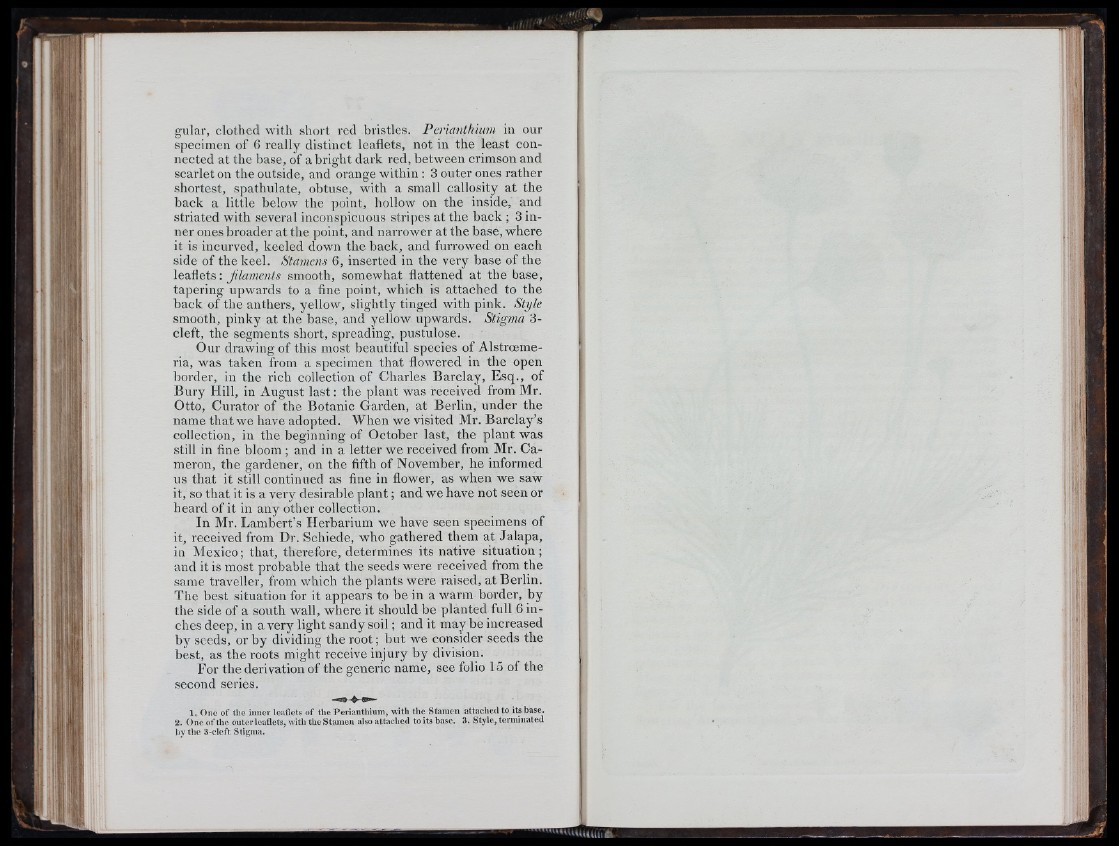
! If :
I'fH l
I =1' 3'
'T.';
gular, clothed with short red bristles. Perianthium in our
specimen of 6 really distinct leaflets, not in the least connected
at the base, of a bright dark red, between crimson and
scarlet on the outside, and orange within : 3 outer ones rather
shortest, spathulate, obtuse, with a small callosity at the
back a little below the point, hollow on the inside, and
striated with several inconspicuous stripes at the back ; 3 inner
ones broader at the point, and narrower at the base, where
it is incurved, keeled down the back, and furrowed on each
side of the keel. Stamens 6, inserted in the very base of the
leaflets: smooth, somewhat flattened at the base,
tapering upwards to a fine point, which is attached to the
back of the anthers, yellow, slightly tinged with pink. Style
smooth, pinky at the base, and yellow upwards. Stigma 3-
cleft, the segments short, spreading, pustulose.
Our drawing of this most beautiful species of Alstrcemeria,
was taken from a specimen that flowered in the open
border, in the rich collection of Charles Barclay, Esq., of
Bury Hill, in August la s t: the plant was received from Mr.
Otto, Curator of the Botanic Garden, at Berlin, under the
name that we have adopted. When we visited Mr. Barclay’s
collection, in the beginning of October last, the plant was
still in fine bloom ; and in a letter we received from Mr. Cameron,
the gardener, on the fifth of November, he informed
us that it still continued as fine in flower, as when we saw
it, so that it is a very desirable p lan t; and we have not seen or
beard of it in any other collection.
In Mr. Lambert’s Herbarium we have seen specimens of
it, received from Dr. Schiede, who gathered them at Jalapa,
in Mexico; that, therefore, determines its native situation;
and it is most probable that the seeds were received from the
same traveller, from which the plants were raised, at Berlin.
The best situation for it appears to be in a warm border, by
the side of a south wall, where it should be planted full 6 inches
deep, in a very light sandy soil; and it may be increased
by seeds, or by dividing the root; but we consider seeds the
best, as the roots might receive injury by division.
For the derivation of the generic name, see folio 15 of the
second series.
t . One of tl’.e inner leaflets of the Periantliium, with the Stamen attached to its base.
2. One of the outer leaflets, witli the Stamen also attaclicd to its base. 3. Style, terminated
by the 3-cleft Stigma.
I;',;
'l : I